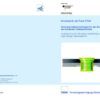Description
P 832 – Coatings of solid self pierce rivets for the use
in high-strength steel materials
The aim of this research project was the development of rivet-element-coatings that serve as a corrosionprotection as well as a hydrogen-barrier. This was based on the galvanic zinc-nickel system. However, the problem is the low efficiency in this type of electrolyte with approx. 50%, while only 50% of the electrical energy is still used to form hydrogen.
Two rivet materials were examined in this research project. The cold heading steel 1.5515 and the chrome-steel 1.4035, which has a chromium content of 13 wt%. This high chromium content leads to a passivation of the material, that results in a complex galvanic coating. By a modified pretreatment of the rivet elements, a significantly improvement of the coatingadhesion on the rivet surface can be achieved. After hydrogen input, a chromium-steel-rivet shows under a quasi-static shearing load, brittle fracture behavior. In corrosion tests the porosity of the coating can also be detected. Therefore, further optimizations for a galvanic
coating process in an aqueous electrolyte are necessary. A PVD coating is also be considered for systems, because these coating-typs have shown good adhesion ability.
In addition, a modified rivet geometry for the chromium-steel-rivet was developed, which has proven well in terms of stability in the setting process as well as the affinity for hydrogen embrittlement. The coating of the cold heading steel rivet showed no negative effects. Here, the modified pretreatment of the rivet elements could be applied too. In addition to the zinc-nickel-coating, there are also the Almac®- and the zinc-plate-coating system available. All coatings are applicable without any problems. In addition, the rivet of 1.5515 shows no failure-abnormalities after hydrogen input. Therefore, at the risk of hydrogendiffusion in to the auxiliary joining part, that rivet should be preferred in comparison to the chromium-steel-rivet. Also in terms of their corrosion-inhibiting impact, the coatings on the cold heading steel rivet showed no abnormalities and are considered to be capable to prevent corrosion on the rivet.
The research project IGF-No. 16459 N from the Research Association for Steel Application was supported by the Ministry of Economic Affairs and Energy through the German Federation of Industrial Research Associations (AiF) as part of the programme for promoting industrial cooperative research (IGF) on the basis of a decision by GermanBundestag. The research project has been carried out at Laboratorium für Werkstoff- und Fügetechnik der Universität Paderborn and at Institut für Werkstoffkunde der Leibniz Universität Hannover.
Only available in german language.
Authors:
G. Meschut, O. Hahn, M. Bergau, H. J. Maier, M. Nicolaus
Published in:
2015




